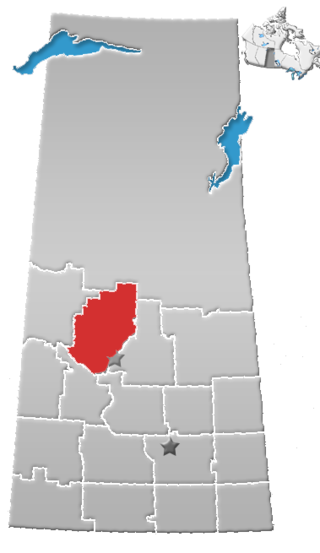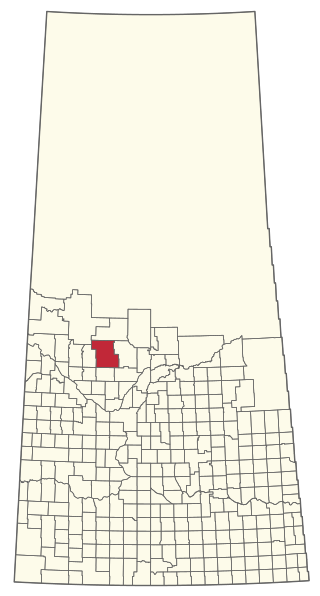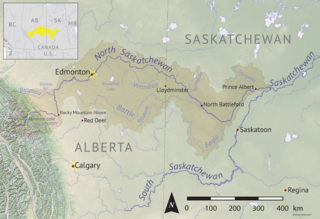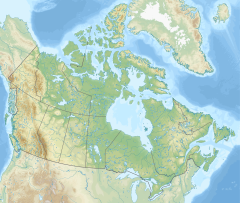
The Rural Municipality of Shellbrook No. 493 is a rural municipality (RM) in the Canadian province of Saskatchewan within Census Division No. 16 and SARM Division No. 5. It is located in the north-central portion of the province west of the City of Prince Albert.

Division No. 16 is one of eighteen census divisions in the province of Saskatchewan, Canada, as defined by Statistics Canada. It is located in the north-central part of the province. The most populous community in this division is North Battleford.
Shellbrook is a rural community in Saskatchewan, Canada located 44.5 km (27.7 mi) west of Prince Albert. The population of the town was 1,433 in 2011. Highways 3, 40, and 55 provide access to the community. Approximately 50 businesses provide a wide range of goods, services, and professional expertise.
Highway 3 is a major provincial paved undivided highway in the Canadian province of Saskatchewan. It runs from the Alberta border, where it continues west as Alberta Highway 45, to the Manitoba border, and then continues east as Highway 77. Highway 3 is about 615 km (382 mi.) long. The CanAm Highway comprises Saskatchewan Highways 35, 39, 6, 3, as well as 2. 59.7 miles (96.1 km) of Saskatchewan Highway 3 contribute to the CanAm Highway between Melfort and Prince Albert.

The Rural Municipality of Spiritwood No. 496 is a rural municipality (RM) in the Canadian province of Saskatchewan within Census Division No. 16 and SARM Division No. 6. Located in the north-central portion of the province, it is west of the City of Prince Albert.
Sturgeon Lake is lake in the Canadian province of Saskatchewan. It is a small, narrow body of water situated in the transition zone between the aspen parkland and boreal forest biomes. It is located along the course of Sturgeon River, which has its headwaters in Prince Albert National Park and the Waskesiu Hills. The Sturgeon River is a tributary of the North Saskatchewan River. A small dam at the eastern end of the lake helps regulate water levels.
Touchwood Hills are a range of hills located in the Canadian province of Saskatchewan. The hills are composed of the "Big" Touchwood Hills and the Little Touchwood Hills. Together they are referred to as the Touchwood Uplands. The hills are in the Prairie Pothole Region of North America, which extends throughout three Canadian provinces and five U.S. states, and within Palliser's Triangle and the Great Plains ecoregion of Canada.

Saskatchewan Highway 693 is a provincial highway in the north central region of the Canadian province of Saskatchewan. It connects the Highway 3/ Highway 55 concurrency near Shellbrook to Highway 240 in Prince Albert National Park. The highway is 44.2 kilometres (27.5 mi) long.

Sturgeon River is a river in the Hudson Bay drainage basin in the central part of the Canadian province of Saskatchewan. It flows from its source in the Waskesiu Hills in Prince Albert National Park to the North Saskatchewan River, just west of the city of Prince Albert.

Spirit Creek is a river located in the Assiniboine River watershed in the Canadian province of Saskatchewan. It begins east of Rama and flows south-east into the north end of Good Spirit Lake. Along its route, it crosses Highway 5 and the CN Railway 3 kilometres (2 mi) west of Buchanan. Just over 3 kilometres (2 mi) south of Buchanan, it crosses Highway 47 and flows into Patterson Lake. From Patterson Lake, it empties into the north end of Good Spirit Lake.
The Cub Hills are a hilly plateau located south-east of the geographical centre of the Canadian province of Saskatchewan. The hills are in the boreal forest ecozone of Canada and the landforms of the hills were shaped more than 10,000 years ago during last ice age. Throughout the Cub Hills, there are dozens of lakes and rivers and several parks. The Cubs Hills are 150 km (93 mi) north-east of Prince Albert and are in the Northern Saskatchewan Administration District and Census Division #18. Several highways criss-cross the plateau to provide access to the various parks and other amenities.

Yorkton Creek, formally known as Little Whitesand River, is a river in the south-east region of the Canadian province of Saskatchewan. The river begins at Leech Lake, south of Yorkton, and flows north into the Whitesand River. The Whitesand River flows east into the Assiniboine River, which is a major tributary of the Red River. While Yorkton Creek begins at Leech Lake, its main tributary, Crescent Creek, has its headwaters in the Beaver Hills to the west.

Crescent Creek is a river in the south-east region of the Canadian province of Saskatchewan. The river begins in the Beaver Hills and flows in an easterly direction into Crescent Lake. Crescent Creek is a tributary of Yorkton Creek, which flows north into the Whitesand River–a tributary of the Assiniboine River.

Big River is a river in the west-central part of the Canadian province of Saskatchewan in the boreal forest ecozone of Canada. The river begins at Witchekan Lake in the RM of Spiritwood No. 496 and heads in a north-easterly direction before emptying into Cowan Lake at the town of Big River. Cowan Lake is the source for Cowan River, which is a major tributary of Beaver River. Beaver River then flows into Lac Île-à-la-Crosse and the Churchill River.

Spruce River, also called Little Red River, is a river in the north-central region of the Canadian province of Saskatchewan. It begins in the Waskesiu Hills in Prince Albert National Park and flows generally in a southward direction through boreal forests, glacier carved hills and valleys, muskeg, and prairie en route to the North Saskatchewan River at the east end of the city of Prince Albert.
Waskesiu Upland is a hilly plateau in the central region of the Canadian province of Saskatchewan. Waskesiu means red deer or elk in the Cree language. The plateau is just south-west of the geographical centre of the province and consists of two main ranges – the Waskesiu Hills to the south and the Thunder Hills to the north The Thunder Hills cover an area of about 225,000 acres. Several notable rivers begin from the upland with ones headed south flowing into the North Saskatchewan River and ones headed north flowing into the Churchill River. Much of the plateau is carpeted in boreal forests and most of the Waskesiu Hills range is within Prince Albert National Park. Besides the national park, there are several provincial recreation sites in and around the upland. The northern part of the upland is part of the Northern Saskatchewan Administration District and is sparsely populated.
Big Shell Lake is a lake in the Canadian province of Saskatchewan. Officially known as Shell Lake, it is commonly called Big Shell Lake to differentiate it from Little Shell Lake, which is about 4.5 kilometres (2.8 mi) downstream. Big Shell Lake is in the RM of Spiritwood No. 496 and the resort villages of Big Shell and Echo Bay are on the south-eastern and eastern shore. Access to the lake and the villages is from Highway 12.

Makwa River is a river in the Canadian province of Saskatchewan in the transition zone between parkland and boreal forest. Makwa is Cree for Loon. The upper reaches of the Makwa River's watershed reach just across the border into Alberta and includes lakes such as Hewett, Ministikwan, Makwa, and Jumbo.
Wood River is a river in the Canadian province of Saskatchewan. It has its source in the Wood Mountain Hills of south-western Saskatchewan and flows in a north-easterly direction to its mouth at Old Wives Lake. Old Wives Lake is a salt water lake with no outflow. As a result, the drainage basin of Wood River is an endorheic one. Along the course of the river, there are several parks, historical sites, and small towns.

Armit River is a river in the Canadian provinces of Manitoba and Saskatchewan in the Nelson River drainage basin. The river begins in the Porcupine Hills of the Manitoba Escarpment at Armit Lake and flows in a northerly direction closely following the Manitoba / Saskatchewan border and into Red Deer Lake along the course of the Red Deer River.











